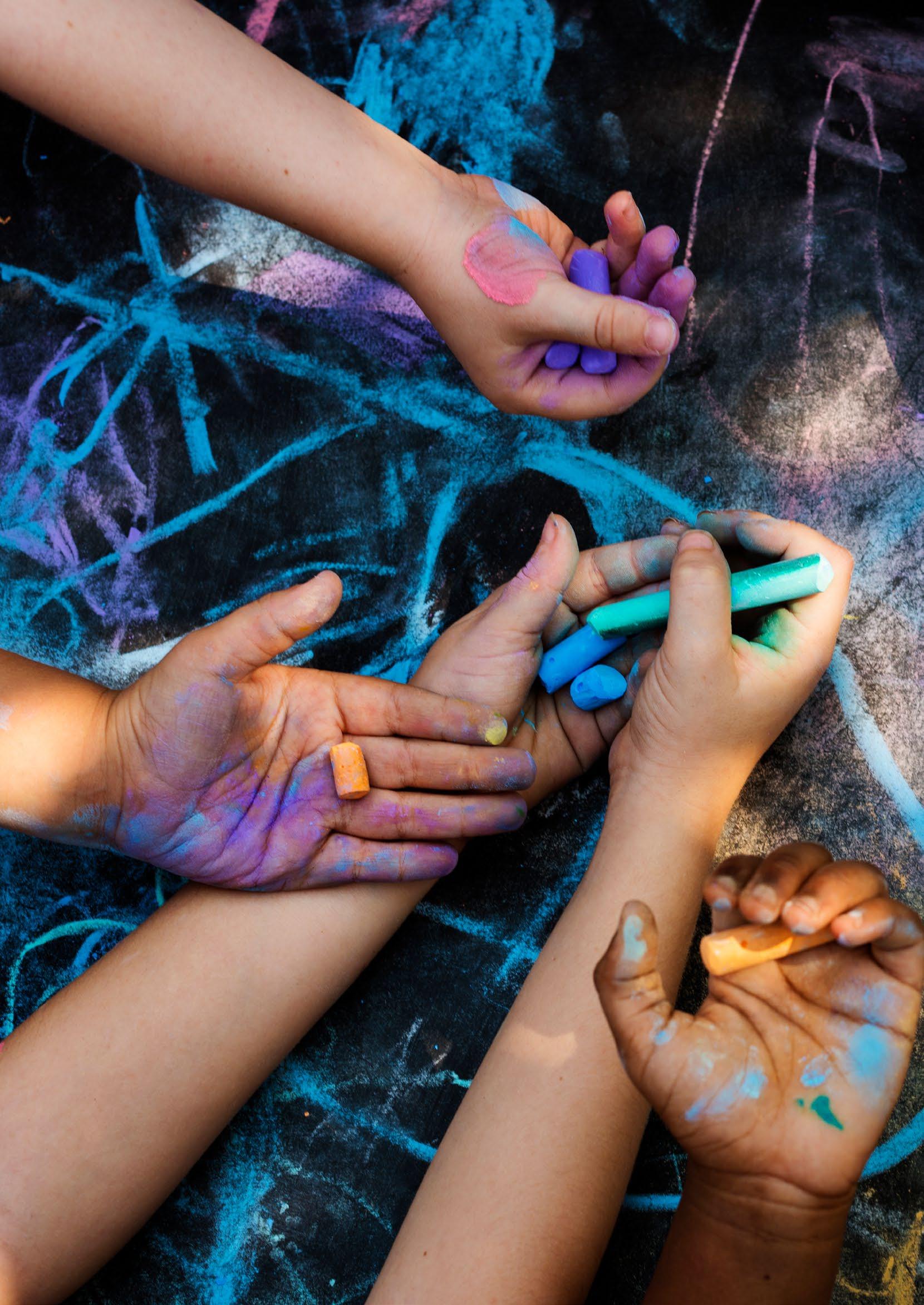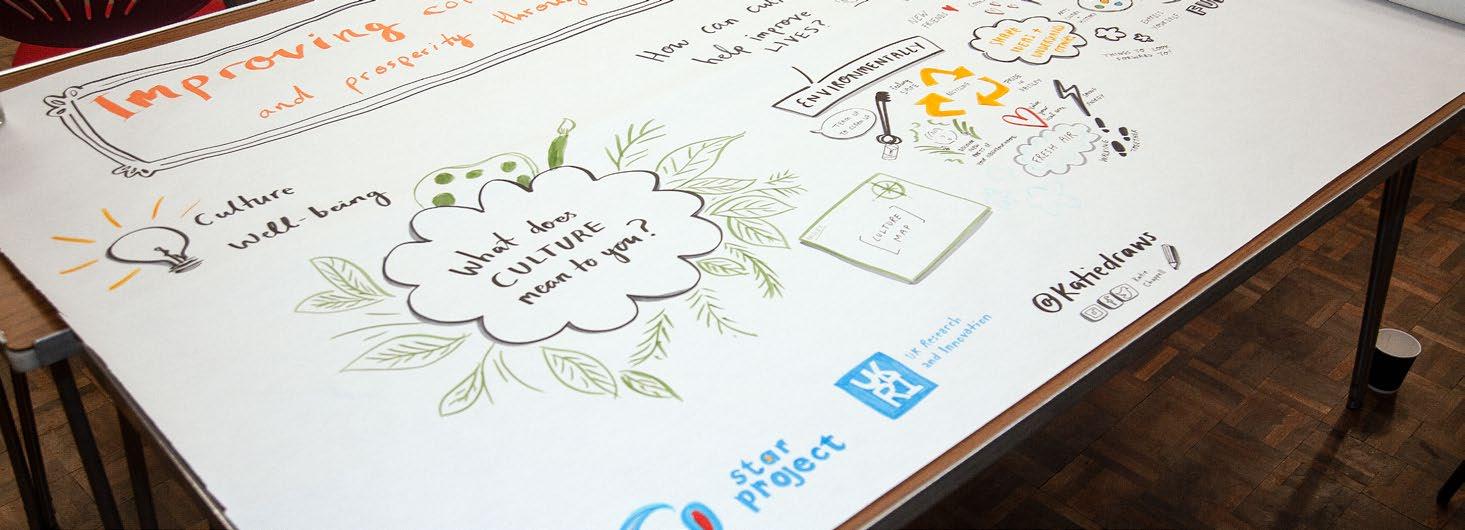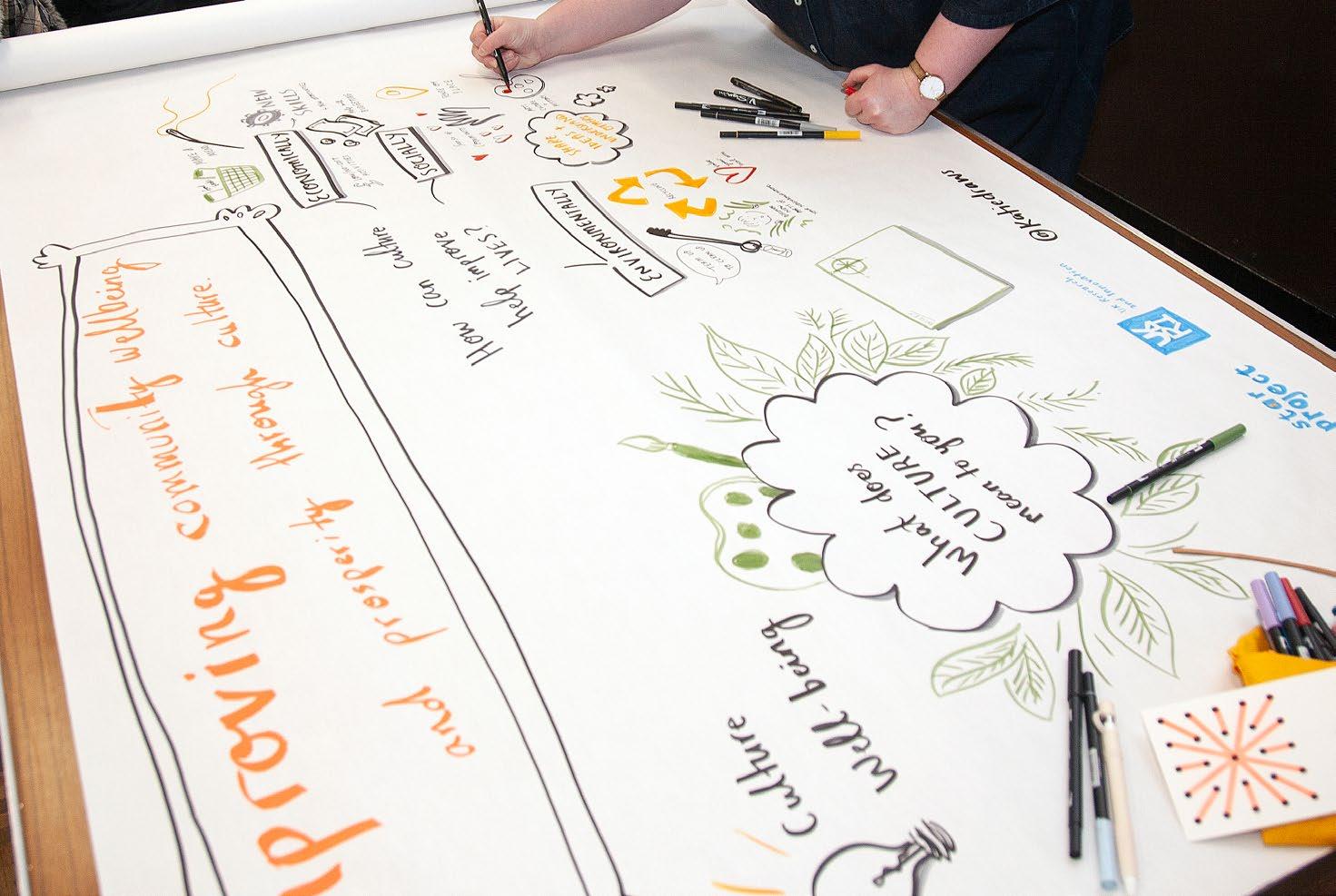
10 minute read
7.0 References
from The Role of Arts & Culture in Lifting Communities Out of Poverty, A Review of Evidence
by ccse_uws
Those working in the field of cultural regeneration, cultural policy, in local government, the third sector or in cultural institutions might increase the leverage achieved through their arts and cultural intervention by taking early steps to consider the following:
Whether an arts or cultural intervention is focussed on tackling material poverty or the effects of poverty and what is possible within the operational confines of the proposed intervention
Advertisement
• is the intervention focussed on tackling material poverty directly or, is it intended to ameliorate the effects associated with poverty? • what is realistically achievable within the operational confines of the proposed intervention?
Which indicators can be used to evidence efficacy from the outset of the arts or cultural intervention and produce transparency about what arts and cultural interventions can and cannot achieve
• what indicators will be used to measure ‘success’? • can clear links between the intervention mechanism (arts or cultural) outputs and outcomes be established? • can a baseline be established so that ‘distance travelled’ can be charted?
The appropriateness of longitudinal data collection methods to collecting evidence of success in arts or cultural interventions to tackle material poverty
• can a baseline be established upon which to assess change over time? • can a systematic approach to gathering and analysing data be implemented at the outset? • what existing data collection methods are in place and which new ones are required to fill data gaps?
The utility of small, focussed, community-based activity in comparison with larger scale, macro-level interventions
• how can an emphasis on community building, confidence building through skills acquisition and mentoring be foregrounded when designing and implementing arts or cultural interventions? • how can participants be involved in the design phase of interventions, identifying the salient issues to be addressed and the approach to be taken?
The need for long term strategic commitment to co-production and the involvement of community members in cultural production if it is to be successful
• how can participants become involved in the cultural production /co-production? • is access to mechanisms of cultural production (section 4.1) feasible? • can access to mechanisms of cultural production (section 4.1) be enabled or enhanced?
Adbowale, V., Farmer, P., Rose-Quirie, A., Jenkins, P., Greatley, A. and Bailey, S. (2014). The Pursuit of Happiness: A new ambition for our mental health, CentreForum. Andrews, K. (2014) Culture & poverty: harnessing the power of the arts culture and heritage to promote social justice in Wales, the Welsh Government, Cardiff, available at: https://gov.wales/sites/default/ files/publications/2019-06/culture-and-poverty-harnessing-the-power-of-the-arts-culture-andheritage-to-promote-social-justice-in-wales.pdf [accessed 7th July, 2020] Arts Council England, (2014) The value of arts and culture to people and society; an evidence review, Arts Council England, Manchester Bakare, L (2020) Tate Britain’s £40k ‘head of coffee’ role sparks row over low curator pay, The Guardian, 29th January available at: https://tinyurl.com/smlgdax Barnes, P. & McPherson, G. (2019) Co-creating ,co-producing and connecting: Museum practice today, The Museum Journal, 62:2 Barraket, J. (2005) Putting people in the picture? The role of the arts in social inclusion, Social Policy Working Paper № 4, Melbourne Bashir, N., & Dayson, C. (2014) The social and economic impact of the Rotherham Social Prescribing Pilot: Main Evaluation Report, Sheffield: CRESR, Sheffield Hallam University Belfiore, E. (2002) Art as a means of alleviating social exclusions: does it really work? A critique of instrumental cultural policies and social impact studies in the UK, International Journal of Cultural Policy, 8:1 Bickerdike, L., Booth, A., Wilson, P.M., Farely, K. & Wright, K. (2017) Social prescribing: less rhetoric and more reality. A systematic review of the evidence, BMJ Open, 7 Black, C. Ingram, J. & Brown, J. (N.D.) Transforming futures: An anti-poverty resource pack to support arts, cultural and heritage organisations as they create pathways to cultural participation for children and young people in Wales, Museum Wales, available at: https://museum.wales/media/31207/TransformingFutures_Resource-Pack.pdf [accessed 2nd July, 2020] Brook, O., O’Brien, D. & Taylor, M. (2018) Panic! Social Class, Taste and Inequalities in the Creative Industries, http://createlondon.org/wp-content/uploads/2018/04/Panic-Social-Class-Taste-andInequalities-in-the-Creative-Industries1.pdf Bungay, H. & Clift, H. (2010) Arts on prescription. A review of practice in the UK, Perspectives in Public Health, 130, 277-281 Butler, W. & Leathem, K. (2014) A social return on investment evaluation of three ‘sport for social change network’ programmes in London, Active Communities Network, London, Manchester, available at: https://static1.squarespace.com/static/5733282860b5e9509bc9c4db/t/5964c1c978d171ed7 9c59732/1499775436857/Social+Return+on+Investment+SROI+-+Active+Communities+Network.pdf [accessed 2nd July, 2020] Campbell, P., Cox, T., Crone, S. & Wilks-Heeg, S. (2015) Evidence of Things That Appear Not’? A critical review of the role of arts and culture in the regeneration of urban places and urban communities, available at: http://www.petersoc.com/wp-content/uploads/2018/01/Campbell-et-al-2015-Evidenceof-Things-That-Appear-Not-AHRC-Cultural-Value.pdf [accessed 2nd July, 2020] CASE (2010) Understanding the drivers, impact and value of engagement in culture and sport, an overarching summary of the research, … Cawston, P. (2011) Social prescribing in very deprived areas, British Journal of General Practice, 61, 350 Chatterjee, H., Camic, P., Lockyer, B., & Thomson, L. (2017) Non-clinical community interventions: a systematised review of social prescribing schemes, Arts & Health, 10:2, 97-123
Clements, P. (2004) The rehabilitative role of arts education in prison: accommodation or enlightenment? JADE, 23:2 Creative Scotland, (2019) Equalities, diversity & inclusion, available at: https://www.creativescotland. com/what-we-do/the-10-year-plan/connecting-themes/equalities-and-diversity [accessed 2nd July, 2020] Cultural Learning Alliance, (2019) The arts for every child: Why arts education is a social justice issue, Cultural Learning Alliance, Briefing Paper №5, available at: https://culturallearningalliance.org.uk/wpcontent/uploads/2019/10/Arts-for-every-child-CLA-Social-justice-briefing.pdf [accessed 2nd July, 2020] Culture, Welsh Language & Communications Committee (CWLC) (2019) Count me in! Tackling poverty and social exclusion through culture, heritage and the arts, CWLC, National Assembly for Wales, Cardiff, available at: https://senedd.cymru/laid%20documents/cr-ld12847/cr-ld12847%20-e.pdf [accessed 2nd July, 2020] Daogo Guingané, J.P. (2013) The role of art in reducing poverty, Museum International, 62:3, 9-12 Daykin, N., Gray, K., McCree, M., & Willis, J. (2016) Creative and credible evaluation for arts, health and well-being: opportunities and challenges of co-production, Arts & Health, 9 (2), 123-138 Deverell, P. (N.D.) Creativity for everyone - supporting cultural access and engagement, available at: https://www.creativescotland.com/explore/read/blogs/creative-scotland/creativity-for-everyonesupporting-cultural-access-and-engagement [accessed 2nd July, 2020] Dirksen, R. (2013) Surviving material poverty by employing cultural wealth: putting music in the service of community in Haiti, Yearbook for Traditional Music, 45, 43-57 Flinn, J. & McPherson, G. (2007) Culture Matters? The role of art and culture in the development of social capital, in Collins, M., Holmes, K. and Slater, A. Eastbourne (eds.) Sport, leisure, culture and social capital – discourse and practice, Leisure Studies Association. Foley, M., Flinn, J. & McPherson, G. (2007) Culture matters, final report, Division of Cultural Business, Glasgow Caledonian University Francis-Devine, B. (2020) ‘Poverty in the UK: statistics. Briefing Paper Number 7096, 29 April 2020.’ Available at: https://commonslibrary.parliament.uk/research-briefings/sn07096/ [accessed 18th June, 2020] Goodlad, R., Hamilton, C. & Taylor, P.D. (2002) Not just a treat: arts and social inclusion – a report to the Scottish Arts Council, Centre for Cultural Policy Research, University of Glasgow Gould, H. (2001) Culture & social capital, in Matarasso, F. (ed.) Recognising culture, Comedia, The Department of Canadian Heritage, and UNESCO Goulden, C. and D’Arcy, C. (2014) A Definition of Poverty, available at: https://www.jrf.org.uk/report/ definition-poverty [accessed 18th June, 2020] Grauer, K., Krug, D., Loucheur, Y. & MacKinnon, E. (2001) Culture, education and skills for living, in Matarasso, F. (ed.) Recognising culture, Comedia, The Department of Canadian Heritage, and UNESCO Hagg, G. (2006) Arts, culture and food security in Southern Africa, commissioned by the South African Department of Arts and Culture, (July). Available at: http://repository.hsrc.ac.za/ handle/20.500.11910/6447, [accessed, 14th March, 2020] Help Musicians (2014) Health and Wellbeing Survey, London: Help Musicians Husk, K., Blockley, K., Lovell, R., Bethel, A., Lang, I., Byng, R. & Garside, R. (2020) What approaches to social prescribing work, for whom, and in what circumstance? A realist view, Health & Social Care in the Community, 28, 309-324 Inman, P. (2020) Number of workers living in poverty rises for third straight year, The Guardian, 7th February, available at: https://tinyurl.com/qrgc8ba Jefferson, P. N. (2018) ‘Poverty. A Very Short Introduction.’ Oxford: Oxford University Press
Jermyn, H. (2001) The arts and social exclusion: a review prepared for the Arts Council of England, available at: http://creativecity.smallboxcms.com/database/files/library/arts_social_exclusion_uk.pdf, [accessed, 5th June, 2020] Kay, A. (2000) Art and community development: the role of the arts have in regenerating communities, Community Development Journal, 35:4 Labour Party, (2017) Acting Up Report. Labour’s inquiry into access and diversity in the performing arts, London: Labour Party Lamont, M. & Small M. L. (2007) Cultural diversity and poverty eradication, Working Paper 2007-25, Background Paper prepared for the World Report on Cultural Diversity, UNESCO, http://nrs/harvard.edu/ urn-3:HUL.InstRepos:10494966 Lloyd, R. (2002) Neo-Bohemia: Art and neighbourhood redevelopment in Chicago, Journal of Urban Affairs, 24:5, 517-532 Long, J., Welch, M., Brambham, P., Butterfield, J., Hyleton, K. & Lloyd, E. (2002) Count Me In: the dimensions of social inclusion though culture and sport, a report for the Department of Culture, Media & Sport … Centre for Leisure and Sport Research Matarasso, F. (1997) Use of ornament? The social impact of participation in the arts, COMEDIA … Matarasso, F. (2017) A restless art: how participation won and why it matters, available at: https:// arestlessart.com/2017/03/09/co-creation/ [accessed 2nd July, 2020] McClymont, K., Jacobs, P. & Cavanagh, B. (2020) Social capital in Scotland: Measuring and understanding Scotland’s social connection, The Scottish Government – Office of the Chief Social Policy Advisor, Edinburgh. Available at: https://tinyurl.com/qpopow2 McPherson, G. (2006) Public memories and private tastes: the shifting definitions of museums and their visitors in the UK, Museum Management and Curatorship, 21 Mossabir, R., Morris, R., Kennedy, A., Blickem, C. & Rogers, A. (2015) A scoping review to understand the effectiveness of linking schemes from healthcare providers to community resources to improve the health and wellbeing of people with long-term conditions, Health & Social Care in the Community, 23 , 467–484 Newman, T., Curtis, K. & Stephens, J. (2001) Do community-based arts projects result in social gains? A review of literature, Community Development Journal, Vol. 38 No. 4, 310-322 Oakley, K. & O’Brien, D. (2015) Cultural Value and Inequality: A Critical Literature Review, AHRC: Swindon Oakley, K. & O’Brien, D. (2016) Learning to labour unequally: understanding the relationship between cultural production, cultural consumption and inequality, Social Identities, Vol. 22, No. 5, 471-486 Payne, J. & Taylor, S. (2017) Where are they now? Post graduate research report, November 2017, Executive Summary, London: Help Musicians Polley, M., Bertolli, M., Kimberlee, R., Pilkington, K., & Refsum,C. (2017) A review of the evidence assessing impact of social prescribing on healthcare demand and cost implications, University of Westminster Rempel, E.S., Wilson, E.N. Durrant, H., Barnet, J. (2017) Preparing the prescription: a review of the aim and measurement of social referral programmes, BMJ Open, 7, 1-9 Ruiz, J. (2004) A literature review of evidence base for culture, the arts and sport policy, Scottish Executive, Edinburgh Sagnia, B.K. (2005) Strengthening local creative industries and developing cultural capacity for poverty alleviation, International Network for Cultural Diversity, Sixth Annual Conference, 17-20 November, Dakar, Senegal Sandell, R. (1998) Museums as agents of social inclusion, Museum Management and Curatorship, 17:4 Shaw, P. (2003) What’s art got to do with it? Briefing paper on the role of the arts in neighbourhood renewal, Arts Council England, London Sim, K.E.A. (2017) The art of participation: the case of creative communities in Indonesia, Community Development Journal, 52:1
Small, M.L., Harding, D.J. & Lamont, M. (2010) Reconsidering culture and poverty, Annals, AAPSS, 629 Social Metrics Commission (2018) ‘A new measure of poverty for the UKA summary of the report by the Social Metrics Commission.’ Available at: http://socialmetricscommission.org.uk/MEASURING-POVERTYSUMMARY-REPORT.pdf [Accessed 18th June, 2020] South, J., Higgins, T.J., Woodall, J. & White, S.M. (2008) Can social prescribing provide the missing link? Primary Health Care Research & Development, 9:? 310-18 Stewart, K. and Roberts, N. (2019) ‘Child Poverty Measurement in the UK: Assessing Support for the Downgrading of Income-Based Poverty Measures.’ Social Indicators Research 142, 523–542. https://doi. org/10.1007/s11205-018-1880-9 The Scottish Government, (2019) A culture strategy for Scotland, The Scottish Government, Edinburgh, available at: https://www.gov.scot/publications/culture-strategy-scotland/pages/7/ [accessed 2nd July, 2020] The Welsh Government, (2019) Fusion, creating opportunities through culture. Delivery in 2019-2020, Cardiff, available at: https://gov.wales/sites/default/files/publications/2019-11/fusion-programmereport-2019-to-2020.pdf [accessed 7th July, 2020] Thomson, L.J., Camic, P.M. & Chatterjee, H.J. (2015) Social prescribing, a review of community referral schemes, University College London: London Titon, J. T. (2013) Music and the US war on poverty: some reflections, Yearbook for Traditional Music, 45 74-82 Wilson, J. (1999) Acknowledging the expertise of patients and their organisations, BMJ, 319, 771-774
Photo: Willie Kay









